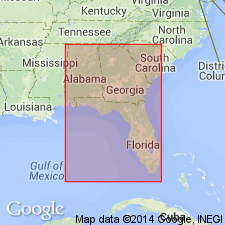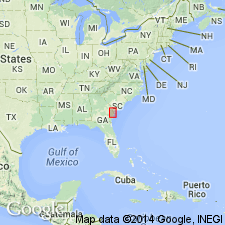
- Usage in publication:
-
- Ochlockonee Formation
- Modifications:
-
- First used
- Dominant lithology:
-
- Limestone
- AAPG geologic province:
-
- South Georgia sedimentary province
Summary:
Name Ochlockonee Formation appears in several figures, but unit is not described in this report. Terminology credited to Bryan (1991: U. of TN Diss). Occurs in the Gulf Trough-Appalachicola Embayment area of southern GA where it underlies Wolf Pit Dolomite (first used) and overlies unnamed limestone. Cross section illustrates it as lowest unit in Mobley Plant Farm core, Colquitt Co., GA. Age is Oligocene.
Source: GNU records (USGS DDS-6; Reston GNULEX).

- Usage in publication:
-
- Ochlockonee Formation
- Modifications:
-
- Named
- Dominant lithology:
-
- Limestone
- Dolomite
- AAPG geologic province:
-
- South Georgia sedimentary province
Summary:
Name Ochlockonee Formation is proposed here for a finely granular to lutitic, variably dolomitic, microfossiliferous limestone restricted to the subsurface in the Gulf Trough of southwestern GA and the eastern panhandle of FL. Unit extends from Jeff Davis Co., GA, southwestward to Calhoun and Liberty Cos., FL, and possibly beyond. Lower part of the Ochlockonee was previously included in the Tallahassee Limestone, while the upper part was included in the Gadsden Limestone. These rocks have also previously been mapped as Ocala, Lisbon, Claiborne, Marianna, Suwannee, and Byram by various authors in various locations. The name Tallahassee limestone of Applin and Applin (1944) is not reintroduced as a name for this formation because no type well was ever designated and as described it is stratigraphically inconsistent. The Gadsden is not used because it would take major revision and expansion of the original concept of the formation. Both the Tallahassee and the Gadsden are "subsumed" under the Ochlockonee Formation of this report. One formal member, the Pridgen Limestone Member, is proposed, but is restricted to the Gulf Trough northeast of the Chattahoochee embayment. The Formation is typically a light olive gray to yellowish gray, hard and tough, variably recrystallized, massive-bedded to thinly bedded, bioturbated and burrowed, finely to very finely granular, even-textured, somewhat argillaceous limestone, variably dolomitic with scattered dolostone intervals. Subordinate components include clay, chert, pyrite, phosphate, glauconite, and microfossils. Composite thickness is 374 ft (114 m) in Colquitt Co., GA. Thickens southwestward to more than 1200 ft in Gadsden Co., FL. Unconformably overlies upper Eocene undifferentiated limestone and conformably underlies the Wolf Pit Dolostone (new) in the type area. Unit is a deep-water channel deposit. An early Oligocene (Vicksburgian) age is supported by benthic and planktonic foraminifers.
Source: GNU records (USGS DDS-6; Reston GNULEX).
For more information, please contact Nancy Stamm, Geologic Names Committee Secretary.
Asterisk (*) indicates published by U.S. Geological Survey authors.
"No current usage" (†) implies that a name has been abandoned or has fallen into disuse. Former usage and, if known, replacement name given in parentheses ( ).
Slash (/) indicates name conflicts with nomenclatural guidelines (CSN, 1933; ACSN, 1961, 1970; NACSN, 1983, 2005, 2021). May be explained within brackets ([ ]).

